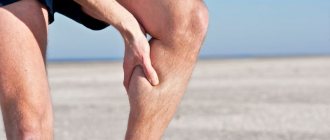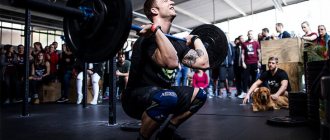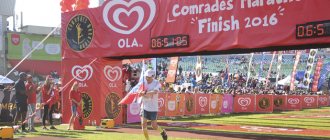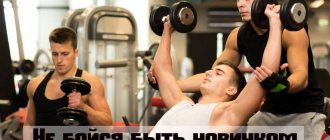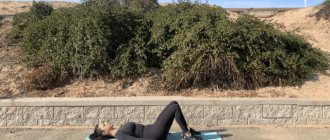The basis of a healthy lifestyle is physical activity. Doctors recommend walking in the fresh air for at least half an hour a day, going to the gym, swimming and doing yoga. However, what should you do if, after training that is beneficial for your body, you are unable to get out of bed due to severe pain? We tell you why this happens and how you can get rid of pain quickly and pleasantly.
Muscle pain after exercise is common
Krepatura: definition
Often the decision to take up sports comes suddenly and is accompanied by a crazy dose of motivation. On the same day or the next, you go to the gym or stadium and give your all 100%. Sweaty but happy, you return home, realizing that you are healthier and stronger than yesterday. However, soon the euphoria from the workout is replaced by body aches, the inability to bend and straighten the limbs, and pain during body movements. Severe fever has knocked on your door.
Krepatura is muscle pain associated with physical activity. It is felt after performing atypical exercises without regular repetitions. Most often this includes push-ups, pull-ups and any loads with weights. Muscles have to sharply stretch and contract under the influence of external forces. Soreness is an indicator of how much you have strained your muscles and joints. The stronger the post-workout pain, the more stress the muscles experienced.
possible localization of muscle pain
Strength exercises with 50% of the working weight
Extreme strength exercises performed with half the working weight are excellent for recovery.
Most exercises require specialized equipment—a trap bar, a fat bar, a giant tire—but some can be done with what regular gyms have.
Here are some options.
Carrying a trap bar
To carry a trap bar as part of a workout, it is advised to use 90% of the weight of the deadlift. If you deadlift 100 kilograms, you would carry a 90 kilogram trap bar in a normal workout, and use a 45 kilogram weight for your recovery session.
Do three sets of 15 steps, gradually increasing the weight by 20 kilograms for each set.
Clean and Press or Jerk
If you are familiar with weightlifting exercises, after a dynamic warm-up you can do a clean or jerk.
It doesn't matter whether you push the barbell up or squeeze it out. It should be above your head with your arms outstretched.
Do five sets of five reps with half the working weight.
Stand deadlift
The stand allows you to better stretch your hamstrings. Try not to bend your knees too much and keep your back straight. Do four sets of five reps of rack deadlifts with half your body weight.
You will find even more extreme strength exercises without special equipment in this article.
Spend your rest days actively, then you will recover faster and suffer less from pain and stiffness. Share your recovery methods in the comments to the article.
Causes of muscle pain
In a normal state, all tissues of the body consume oxygen at a predetermined intensity. Under the influence of sudden muscle contractions during exercise, oxygen begins to be consumed at a faster rate. Often cells are not ready to spend so much oxygen, since before this there were no prerequisites indicating that reserves need to be increased. Hypoxia occurs, due to which the muscles are forced to switch to another, emergency method of obtaining energy - anaerobic glycolysis.
Anaerobic glycolysis is the conversion of glucose into energy in an oxygen-free environment. As a result, two substances are released - ATP molecules, which provide energy, and lactate, a derivative of lactic acid. It is the second component that leads to muscle soreness after physical activity.
Under conditions of unexpected stress, the level of lactate in cells increases several tens of times. At the same time, in a normal state, lactic acid is useful to the body and is responsible for the process of reverse glycolysis in the liver.
anaerobic glycolysis
Post-workout pain may be felt due to microtrauma in the muscles. When performing pulling exercises or after a fast run, the myofibrils in the muscles - the elements responsible for muscle contractions - become very tense. If long myofibrils can withstand the load, then short ones quickly break. This is what causes pain.
Which muscles should ache after training?
Obviously those that your exercises were aimed at. That is, if, when lifting the barbell, your biceps and triceps hurt, then the exercise can be considered completed successfully, you have achieved the desired result. If, during the same exercise, a burning sensation occurs in the back area, you should immediately stop doing it. This means that the execution technique was not followed. Although sometimes a situation arises that a trainee, due to inexperience or lack of understanding, harms his health, much more often the cause of injury is negligence and neglect of safety precautions, which trainers tirelessly repeat in the gym.
Types of pain after training
The release of lactate directly depends on the intensity of the workout. However, inexperienced athletes often confuse intensity with efficiency. The established opinion that muscle pain is a sign of high-quality muscle work is fundamentally wrong. Don’t worry and stop exercising if you feel severe discomfort after the first time. It is important to understand a few points so that this does not happen again in the future:
- Muscle pain is really not an indicator of the effectiveness of the exercise . Because it can be caused by various reasons and even consist of diseases existing before training. It is important to consult with your doctor and coach before setting Olympic records in the gym.
- Lactic acid and glucose are substances not alien to the body. They are always present in muscles and tissues, and their single release means stress, but is quickly leveled out. Typically, a characteristic burning sensation appears at the end of the approach. At this point, the body is at its limit, pushing hard for the last rep, and lactic acid-induced pain sets in. At such moments, you can and should always stop . The body itself tells you your capabilities at this stage, and you definitely won’t become healthier by increasing repetitions or speed. Discomfort may last throughout the workout and for 2–4 hours afterwards.
But our body knows how to cope with stressful conditions. At the end of physical stress, the blood flow restores its previous speed and begins to flush out the resulting lactate reserves from the tissues. It goes away along with sweat and urine, and gradually the pain subsides.
pain during exercise
A slightly different mechanism for the increase and relief of pain occurs if discomfort occurs the next day and lasts about 1-2 days. This phenomenon is called delayed pain .
Delayed pain is unpleasant in the context of normal life activities. It is difficult to get up and go to bed, climb stairs and raise your arms. The worst thing is that such pain deprives you of any motivation to continue exercising. After a person begins to feel comfort in his muscles again, he comes to the gym and again may experience pain, since there was a long break between workouts.
Late pain is caused by microtrauma associated with myofibril ruptures. Immediately after the rupture, no pain is felt, but the next day a slight inflammation in the muscles begins. There is no need to panic in this situation. Inflammation of muscle fibers is not associated with infection and microbes. Discomfort is caused by tissue reaction to stress. After 1-2 days, the tears will heal and muscle mass will grow. You will be able to return to your normal lifestyle.
Method 6: Eat Healthy Foods
Post-workout nutrition depends solely on the purpose of your workout. If the goal is weight loss, experts recommend turning to foods that contain a high amount of protein or a minimal amount of carbohydrates, for example, boiled skinless chicken breast or steamed pollock.
If the goal of training is to gain muscle mass, you need to combine proteins and carbohydrates in a ratio of 1:4. However, the exact numbers depend on the intensity of the workout and the time spent on it, and, of course, health. This ratio is appropriate for absolutely healthy people who train intensively for an hour.
If you decide to resort to sports nutrition, consult your doctor first, because it has a number of side effects. Nowadays, there are three types of sports supplements - for building muscle mass, burning fat and recovering from physical activity. Also on sale you can find multicomponent complexes aimed at solving several problems, and pre-workout complexes of amino acids and vitamins designed to increase endurance, speed up metabolic processes and maintain hormonal levels.
Roskontrol experts assure that there is no universal recommendation for choosing sports nutrition
When purchasing, it is important to focus on the training program, the goal you want to achieve, and the recommendations of the trainer. You should also remember that you cannot base your diet on sports nutrition, they are only an additive that affects metabolic processes
It is imperative to replenish reserves of all vital substances by eating meat, fish, poultry, cottage cheese, cereals, vegetables and fruits.
How to get rid of muscle pain: physical and skincare treatments
It is believed that the best medicine for the onset of sore throat is time. Indeed, the body needs time to flush out excess substances and heal minor injuries in the muscles. But you can speed up this process thanks to a few simple rules.
- Movement is life . When your body aches in pain and every movement becomes a painful ordeal, you want to lie down and not get up for several days. However, it is important to keep moving to speed up your recovery. It’s better to forget about intense training for a while, but no one has canceled walks. You can take care of your body immediately after training. A 2012 study found that athletes who performed low- or moderate-intensity sets immediately after exercise experienced less muscle pain. Relax, sit or lie in a comfortable position, restore your breathing and slowly stretch every inch of your body. The next day you'll be grateful you took the time to do this.
- Stay warm. After major operations, doctors send patients for warming so that the sutures heal faster. You can perform the same manipulations with microtraumas. If you are experiencing delayed pain, try warming up your muscles after exercise. Gentle stimulation will increase blood flow, relieving soreness and making you feel better. To do this, run a warm bath and add Epsom salts to the water. Magnesia weakens spasms and relieves pain. It is important that the water is not scalding, otherwise you may get burned. If necessary, you can repeat several times a day.
thermal procedures with salt
- Drinking and food regime. Excess lactate is eliminated from the body through sweat and urine, which means the same rule applies here as with respiratory diseases: if you drink more, you will recover faster. The water norm can be calculated using the formula: every kilogram of body weight multiplied by 30 milliliters of water. The final amount should be consumed within a day. You also need to watch your diet. Pay attention to foods high in vitamins A, C and E. These include natural oils, green and yellow vegetables, eggs, and fish. The more of them you have in your daily diet, the easier it will be to bear the pain from training. A bonus from the resulting protein will be an increase in muscle mass.
- Cold and hot shower . Changing the temperature during water procedures will tone the muscles and speed up blood flow, which will contribute to a speedy recovery.
Remember : if the pain does not go away seven days after training, and severe swelling appears in the arms and legs, you should immediately consult a doctor. An accumulation of oxygen can form in the cells, which will lead to oversaturation of the body and poisoning of myoglobin proteins. It is responsible for oxygen transport and kidney function. Due to poisoning, an important organ may become damaged or even fail.
swelling in the legs
It is important to pay attention to care procedures. First of all, try a massage. This can be either a relaxing session with a massage therapist or self-massage at home. They relieve muscle tension, increase blood flow and improve joint mobility. For muscle pain, turn to gentle techniques. Study the points of the body responsible for different organs and tissues. Light pressure is preferable to deep tissue massage for muscle recovery.
As a massage oil, use a mix of oils from Epsom.pro. It contains eight oils, each of which is responsible for an individual restorative function. Wheat germ and rice bran oil saturates the skin with amino acids. Orange removes excess fluid from tissues, maintaining hydrolipid balance. Almonds relieve pain and relieve mild cramps. Citrus oils of lemon, lime and lemongrass restore reddened skin to a healthy appearance and even tone. Jojoba oil will correct stretch marks and cellulite deposits.
relaxing oil massage
Taking a relaxing bath is an essential ritual when recovering from workouts. It is better to replace the usual foam with natural salts. Magnesia is perfect. Epsom salts are a natural source of magnesium, which is not synthesized by the body itself. In turn, this component is part of more than 300 enzymes. It is responsible for the functioning of the nervous system, sound sleep and mood. Magnesium salts have a pain-relieving effect on tense muscles. Thanks to their small molecules, they easily penetrate the skin and trigger regeneration processes in it, which has a positive effect on metabolism and fat burning.
Epsom bath salts
The “Muscle care” bath shimmer will take you on a long-awaited journey. Imagine how in a warm bath you feel the aromas of the morning winter forest. Refreshing mint and a coniferous shade of juniper are responsible for this. The mixture will gently relieve tension from muscles and joints and speed up the healing of injuries. The essential oils contained in the salt accelerate blood flow and relieve headaches and spasms. Juniper esters have bactericidal properties and improve immunity. This is especially true if after training you accidentally come under the powerful air conditioner of the gym. The contrast of a hot bath and the pleasant chill of the mix will give you the desired relaxation and restore your body.
salt with mint and juniper oils
The benefits of one type of salt are invaluable, but in combination with other compounds it can work wonders. We recommend trying a mix of Epsom salt, pink Himalayan salt and Dead Sea salt. It is no coincidence that this composition is called “All Desires”. Salt consists of 99.5% natural substances, namely magnesium sulfate and naturally occurring sodium chloride. They contain bromides, zinc and more than 80 other elements necessary for rapid muscle recovery and maintaining overall body tone. Magnesium in Epsom salts acts as a vasodilator. Sea salt contains components that have antiseptic and smoothing effects. Iodine impurities are responsible for increasing immunity. Pink Himalayan salt will relieve tension after a hard day on the move, and will have a calming and anti-inflammatory effect. The skin will get rid of toxins and impurities, the pores will expand so that excess moisture comes out faster.
mix of three salts
A high concentration of magnesium is concentrated in magnesium oil. The product is multifunctional: it can be added to the bath, used as a massage lotion or sprayed in the room. It relieves muscle tension and has a healing effect, which is so necessary after an intense workout. Magnesium chloride, when used regularly, will strengthen your joints. Subsequent workouts will be easier to bear.
magnesium oil
Principles of competent training
The individual training program requires an integrated approach (www.club-olimp.ru)
Beginners who come to the gym for the first time often make a common mistake: in their desire to quickly pump up sculpted muscles or shed those annoying pounds, they take on too much load.
An ill-conceived workout can lead to sprains and microtraumas in muscle fibers. Haste in such matters is always punishable. The pain that occurs in the muscles after such training is sharp and unpleasant.
Intense exercise, especially at first, causes lactic acid to be released into the muscles. It just irritates the nerve endings, so after active exercise you feel a characteristic burning sensation and pain in the muscles.
It is important to properly distribute the load and draw up a training plan with a trainer or yourself. Muscles should rest every 48 hours and, preferably, alternate them, and not constantly put stress on the same ones.
You should definitely start your workout with a warm-up and simple exercises. 10-15 minutes on a treadmill is quite suitable for this. Loads need to be increased gradually.
To prevent dehydration, be sure to drink water before, during and after exercise. Ideally, this is mineral water. Dehydration quickly depletes the body, which leads to fatigue and premature termination of training.
Ways to relieve fatigue after exercise
Fatigue that appears after intense physical activity should not be a reason for prolonged interruption of exercise. Sometimes correction of their duration and intensity is required, but long pauses are contraindicated to relieve muscle fatigue. Rest after classes is required to fully recuperate.
After a set of exercises, a tired body can be supported with protein shakes or fresh juices.
The primary point is the introduction of proteins and carbohydrates into the diet after training to replenish the lost energy balance. This could be chicken breast and eggs. In this matter, it is advisable to consult a trainer for an individual calculation of carbohydrate consumption.
An excellent way to relieve severe fatigue after training is a massage using warming ointments and creams.
A contrast shower not only removes sweat, but also relieves muscle tension, tones and improves overall mood.
A necessary element is, of course, healthy, full sleep, when the body is fully restored.
For people who are actively involved in sports and pay a lot of attention to exercise, special vitamins and dietary supplements have been developed.
B vitamins, vitamins C and E, substances such as L-carnitine, Riboxin, Panangin, Methionine and calcium supplements are necessarily included in addition to the developed nutrition program.
To prevent loss of strength after training, there is a complex of plant adaptogens: ginseng, lemongrass, pantocrine.
The rules are simple, but if you follow them, they will help you effectively overcome fatigue and recover faster after hard training.
When can I continue training?
The next workout should not be done until the pain has subsided. The point is that injuries need to heal. If you start to strain the injured muscles again, you can overtrain. There will be no progress in this state. There will only be a bad mood and feeling.
Muscle pain demonstrates that the training went well and the load was selected adequately. But after that you definitely need a break. Only in a normal state with exercise will the muscles grow in strength and volume.
You can stop by the fitness room to do split training or recovery exercises. Properly selected physical activity will speed up blood flow and also improve metabolism. This way you can help your muscles return to normal. But under no circumstances should you strain the muscles injured in the previous workout even more.
